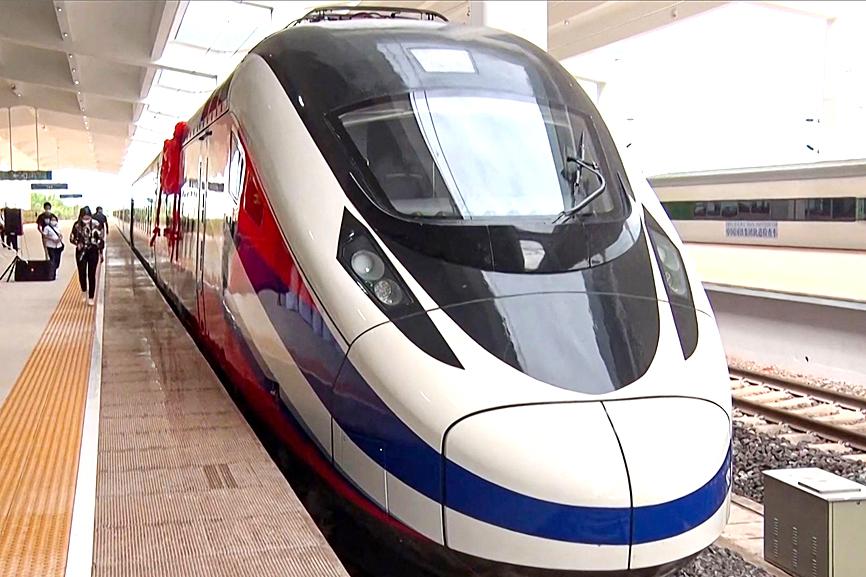A new US$6 billion Chinese-built railway line opens in Laos this week, bringing hopes of an economic boost to the reclusive nation, but experts are questioning the benefits of a project that has seen thousands of farmers evicted from their land.
The 414km route, due to open on Friday, took five years to construct under China’s Belt and Road Initiative, which funds infrastructure projects aimed at increasing Beijing’s clout globally.
Struggling strawberry farmer Anouphon Phomhacsar is hoping the new railway will get his business back on track.

Photo: AFP / Lao National TV via AFPTV
His farm usually produces up to 2 tonnes of the red heart-shaped fruits a year, but the COVID-19 pandemic has hit this year’s harvest hard.
It takes Phomhacsar three to four hours to send his strawberries to Vientiane by road, but he hopes the new railway will cut this delivery time in half.
He says it would also be easier for tourists to travel to camp under the stars and pick berries.
“In the future, foreign tourists coming to the farm could be in the tens of thousands,” he told reporters.
The train route is to connect the Chinese city of Kunming to the Laotian capital, with grand plans for high-speed rail to ultimately snake down through Thailand and Malaysia to Singapore.
Infrastructure-poor Laos, a reclusive communist-run country of 7.2 million people, previously had only 4km of railway tracks.
However, now, sleek red-blue-and-white bullet trains are to speed along the new line at up to 160kph, passing through 75 tunnels and across 167 bridges, stopping at 10 passenger stations.
Despite registering only dozens of COVID-19 cases until April, Laos’ economy took a pandemic battering — economic growth declined to 0.4 percent this year, the lowest level in three decades, according to the World Bank.
Hopes for a rebound this year were dashed — Laos locked down as it clocked up about 70,000 infections in the past eight months.
While the railway could boost tourism, freight and agriculture, according to a World Bank report, the government needs to undertake substantial reforms, including improving border clearance processes.
“The new railway is a major investment that has the potential to stimulate the Lao economy and allow the country to take advantage of its geographical position at the heart of mainland Southeast Asia,” Sombath Southivong, a senior World Bank infrastructure specialist, told reporters.
The tourism industry is desperate for a pick-me-up after the pandemic caused an 80 percent downturn in international traveler numbers last year — 4.7 million foreign tourists visited the previous year.
Pre-pandemic young nomads crammed on to buses at Vientiane for the four-hour ride to adventure capital Vang Vieng — a journey that would take about an hour by train.
The town, which has a former CIA airstrip, was notorious for backpackers behaving badly at jungle parties before it rebranded as an eco-tourism destination.
However, the kayaks, river rafts, ziplines and hot-air balloons have been empty of late.
Inthira — a boutique hotel nestled on the banks of the Nam Song River — shifted from a full occupancy rate to only a trickle of domestic travelers on weekends, general manager Oscar Tality said.
Tality hopes the railway and reduced travel times will give the industry a shot in the arm.
“Along the way people will see magnificent views of the mountains and will cross over bridges and tunnels. It will be a wonderful trip for those on the train,” Tality told reporters.
Despite local optimism, some Laos watchers are concerned about the long-term viability of the project.
“The issue for Laos though is whether their economy ... their private sector is positioned to take advantage of this transport system,” Australian National University lecturer Greg Raymond told reporters.
Two-thirds of Laotians live in rural villages toiling on the land, and the minimum wage is about US$116 a month — a reported US$13.30 train fare from Vientiane to the border town of Boten has attracted some social media criticism for being too expensive.
“When you look at the juxtaposition of this super-modern railway and the countryside it is passing through — it’s very stark. One does wonder whether the Laos people will be the beneficiaries?” Raymond said.
The project has left about 4,400 farmers and villagers reeling after they were forced to surrender land.
Many have faced long delays receiving compensation or have been paid inadequate amounts, the Lao Movement for Human Rights said in a report.
“The compensation rate is very low. If you are asking villagers to move, how can they afford new land?” Laotian lawmaker Vilay Phommixay told parliament in June last year.

DOUBLE-MURDER CASE: The officer told the dispatcher he would check the locations of the callers, but instead headed to a pizzeria, remaining there for about an hour A New Jersey officer has been charged with misconduct after prosecutors said he did not quickly respond to and properly investigate reports of a shooting that turned out to be a double murder, instead allegedly stopping at an ATM and pizzeria. Franklin Township Police Sergeant Kevin Bollaro was the on-duty officer on the evening of Aug. 1, when police received 911 calls reporting gunshots and screaming in Pittstown, about 96km from Manhattan in central New Jersey, Hunterdon County Prosecutor Renee Robeson’s office said. However, rather than responding immediately, prosecutors said GPS data and surveillance video showed Bollaro drove about 3km

‘MOTHER’ OF THAILAND: In her glamorous heyday in the 1960s, former Thai queen Sirikit mingled with US presidents and superstars such as Elvis Presley The year-long funeral ceremony of former Thai queen Sirikit started yesterday, with grieving royalists set to salute the procession bringing her body to lie in state at Bangkok’s Grand Palace. Members of the royal family are venerated in Thailand, treated by many as semi-divine figures, and lavished with glowing media coverage and gold-adorned portraits hanging in public spaces and private homes nationwide. Sirikit, the mother of Thai King Vajiralongkorn and widow of the nation’s longest-reigning monarch, died late on Friday at the age of 93. Black-and-white tributes to the royal matriarch are being beamed onto towering digital advertizing billboards, on

Tens of thousands of people on Saturday took to the streets of Spain’s eastern city of Valencia to mark the first anniversary of floods that killed 229 people and to denounce the handling of the disaster. Demonstrators, many carrying photos of the victims, called on regional government head Carlos Mazon to resign over what they said was the slow response to one of Europe’s deadliest natural disasters in decades. “People are still really angry,” said Rosa Cerros, a 42-year-old government worker who took part with her husband and two young daughters. “Why weren’t people evacuated? Its incomprehensible,” she said. Mazon’s

POWER ABUSE WORRY: Some people warned that the broad language of the treaty could lead to overreach by authorities and enable the repression of government critics Countries signed their first UN treaty targeting cybercrime in Hanoi yesterday, despite opposition from an unlikely band of tech companies and rights groups warning of expanded state surveillance. The new global legal framework aims to bolster international cooperation to fight digital crimes, from child pornography to transnational cyberscams and money laundering. More than 60 countries signed the declaration, which means it would go into force once ratified by those states. UN Secretary-General Antonio Guterres described the signing as an “important milestone,” and that it was “only the beginning.” “Every day, sophisticated scams destroy families, steal migrants and drain billions of dollars from our economy...